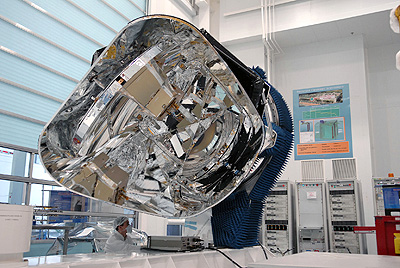ESA’s Planck satellite, due to study relic radiation from the Big Bang, is on display for the media tomorrow in Cannes.  Credits: ESA-S. Corvaja
Credits: ESA-S. Corvaja
Planck will make the most accurate maps yet of the microwave background radiation that fills space. It will be sensitive to temperature variations of a few millionths of a degree and will map the full sky in nine wavelengths.
The immediate outcome of the Big Bang and the initial conditions for the evolution in the universe’s structure are the primary target of this important mission. From the results, a great deal more will be learnt not only about the nature and amount of dark matter, the ‘missing mass’ of the universe, but also about the nature of dark energy and the expansion of the universe itself.
To address such challenging objectives, Planck will need to operate at very low, stable temperatures. Once in space, its detectors will have to be cooled to temperature levels close to absolute zero (-273.15ºC), ranging from -253ºC to only a few tenths of a degree above absolute zero. The Planck spacecraft thus has to be a marvel of cryotechnology.
After integration, Planck will start a series of tests that will continue into early-2008. It will be launched by end-July 2008 in a dual-launch configuration with Herschel, ESA’s mission to study the formation of galaxies, stars and planetary systems in the infrared.
Note: This article has been adapted from a news release issued by the European Space Agency.